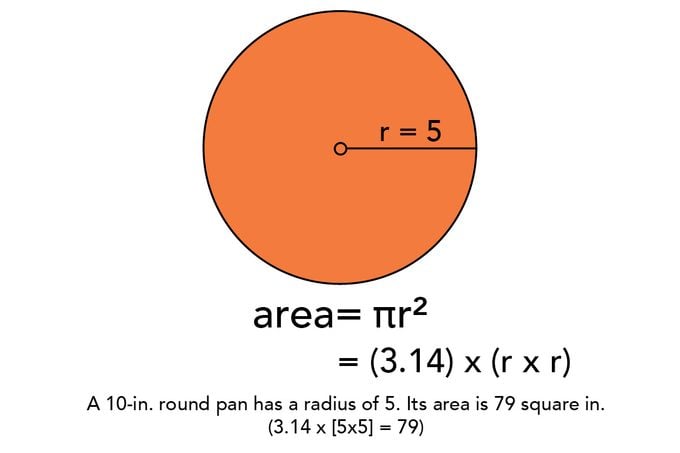The foolproof way to adjust baking recipes to fit any pan? Just use a little math that you learned in middle school. Here's how to do baking pan conversions.

How to Adapt Baking Recipes for Different Pan Sizes

So you want to make the ultimate layered carrot cake … for a party of four. Or you want to morph that devil’s food cake into a 13×9 potluck dessert. How do you adapt recipes for different baking pan sizes? Turns out, it isn’t as tough as you might think.
We’ve done the math on common pans for you in the chart below, so you can create desserts for two—or for 20—with confidence. If you’d like to figure out the math for yourself, read on. (Psst: While you’re at it, you may want to check out how to cut down a recipe.)
Baking Pan Conversion Chart
| If you don’t have this… | Use this instead |
| 9×5-inch loaf pan | Three 5-3/4 x 3-inch mini loaf pans |
| 8×4-inch loaf pan | Two 5-3/4 x 3-inch mini loaf pans |
| 9-inch round | 8-inch square |
| Two 9-inch rounds | 13×9-inch pan |
| 24 muffin cups | 48 mini muffin; 12 jumbo |
| 11×7-inch pan | 10″ Cast-iron skillet |
| 13×9-inch pan | 12-inch skillet |
How to Convert a Recipe to Any Size Pan
When baking cakes, brownies and other batter-y foods, find the area of the pan you want to use and compare it to the pan called for in the recipe. This will give you a good idea of how your pan measures up, and you can increase or trim back the recipe accordingly.
Calculate the area
Calculate the pan’s area, which is described in square inches, using its dimensions. You’ll remember the simple equations below from your school days.
Rectangular and square pans
Find the area by multiplying the length by the width.

Here are the calculations for common square and rectangular pans.
- 6-inch square pan = 36 square inches
- 8-inch square pan = 64 square inches
- 9-inch square pan = 81 square inches
- 11×7-inch pan = 77 square inches
- 13×9-inch pan = 117 square inches
- 15×10-inch jellyroll pan = 150 square inches
Editor’s Tip: An 11×7-inch pan is about 2/3 the size of 13×9: (77 / 117 = 65%). Don’t want to make a big 13×9-inch pan? Make 2/3 of a batch of the recipe. Alternatively, you can multiply any 11×7 recipe by 1.5 and turn it into a crowd-pleasing 13×9 recipe.
Round pans
To find the area of a circle, you multiply π (3.14) by the radius, squared. Radius is the distance from the center of a circle to the outside. To find it, simply divide the diameter of your round pan by two.

Here are the calculations for common round pans.
- 6-inch round = 3.14 x [3 x 3] = 28 square inches
- 8-inch round = 3.14 x [4 x 4] = 50 square inches
- 9-inch round = 3.14 x [4.5 x 4.5] = 64 square inches
- 10-inch round = 3.14 x [5 x 5] = 79 square inches
- 12-inch round = 3.14 x [6 x 6] = 113 square inches
- 15-inch round = 3.14 x [7.5 x 7.5] = 177 square inches
- 18-inch round = 3.14 x [9 x 9] = 254 square inches
Editor’s Tip: A pan’s dimensions are measured from inside wall to inside wall—not from its outer edges.
Determine the volume
Determine the volume by multiplying the area by the height.
Cake pans are generally the same height, so you don’t have to go wild here. But remember that pans of very different heights (such as a tall loaf pan vs. a shallow cake pan) will create different end products.
Deep pan shapes, such as loaf pans, require a longer bake time than shallow pans, such as tart pans or jelly-roll pans. It takes the heat longer to get to the middle of a loaf pan, whereas the contents of a jelly-roll pan are more spread out for quicker baking.
If you bake a sugary cake batter in a loaf pan, it may be over-browned on the outside by the time the inside is done. Likewise, banana bread baked in a cake pan will likely be drier than bread baked in a loaf pan, which is more dense and has less surface area exposed.
Editor’s Tip: For the best results, bake in a similar-shaped pan—just a different size. You’ve got this!




















